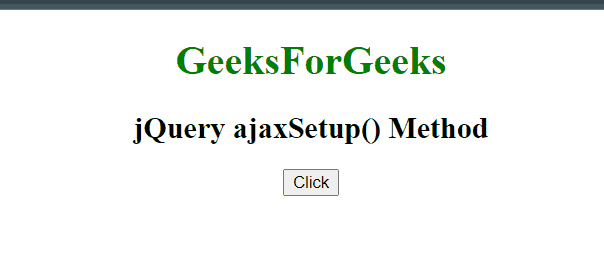jQuery ajaxSetup() Method (original) (raw)
Last Updated : 12 Jul, 2023
The **ajaxSetup() method in jQuery is used to set the default values for future AJAX requests.
**Syntax:
$.ajaxSetup( {name:value, name:value, ... } )
**Parameters:
- **type: It is used to specify the type of request.
- **url: It is used to specify the URL to send the request to.
- **username: It is used to specify a username to be used in an HTTP access authentication request.
- **xhr: It is used for creating the XMLHttpRequest object.
- **async: It's default value is true. It indicates whether the request should be handled asynchronously or not.
- **beforeSend(xhr): It is a function that is to be run before the request is sent.
- **dataType: The data type expected of the server response.
- **error(xhr, status, error): It is used to run if the request fails.
- **global: It's default value is true. It is used to specify whether or not to trigger global AJAX event handles for the request.
- **ifModified: It's default value is false. It is used to specify whether a request is only successful if the response has changed since the last request.
- **jsonp: A string overriding the callback function in a jsonp request.
- **jsonpCallback: It is used to specify a name for the callback function in a jsonp request.
- **cache: It's default value is true. It indicates whether the browser should cache the requested pages.
- **complete(xhr, status): It is a function that is to be run when the request is finished.
- **contentType: It's default value is: "application/x-www-form-urlencoded" and it is used when data send to the server.
- **context: It is used to specify the "this" value for all AJAX-related callback functions.
- **data: It is used to specify data to be sent to the server.
- **dataFilter(data, type): It is used to handle the raw response data of the XMLHttpRequest.
- **password: It is used to specify a password to be used in an HTTP access authentication request.
- **processData: It's default value is true. It is used to specify whether or not data sent with the request should be transformed into a query string.
- **scriptCharset: It is used to specify the charset for the request.
- **success(result, status, xhr): It is to be run when the request succeeds.
- **timeout: It is the local timeout for the request. It is measured in terms of milliseconds.
- **traditional: It is used to specify whether or not to use the traditional style of param serialization.
****Example 1:**This example uses ajaxSetup() method to call data from other files.
**geeks1_data.txt: This text file is called within an HTML file.
Welcome to GeeksforGeeks
**gfg.html
html `
jQuery ajaxSetup() Method<script src=<script>
$(document).ready(function () {
$("li:parent").css("background-color", "green");
});
</script><h1 id="geeks1" style="color:green">
GeeksForGeeks
</h1>
<h2 id="geeks2">
jQuery ajaxSetup() Method
</h2>
<h3></h3>
<button>Click</button>
<!-- Script to use ajaxSetup() method -->
<script>
$(document).ready(function () {
$("button").click(function () {
$.ajaxSetup({
url: "geeks1_data.txt",
success: function (result) {
$("h3").html(result);
}
});
$.ajax();
});
});
</script>`
**Output:

**Example 2: This example illustrates ajaxSetup() method.
html `
jQuery ajaxSetup() Method<script src=<script>
$(document).ready(function () {
$("li:parent").css("background-color", "green");
});
</script><h1 id="geeks1" style="color:green">
GeeksForGeeks
</h1>
<h2 id="geeks2">
jQuery ajaxSetup() Method
</h2>
<button>Click</button>
<!-- Script to use jQuery ajaxSetup() Method -->
<script>
$(document).ready(function () {
$("button").click(function () {
$.ajaxSetup({
url: "geek2_dat.txt", error: function (xhr) {
alert("Error: " + xhr.status + " " + xhr.statusText);
}
});
$.ajax();
});
});
</script>`
**Output:
 other files
other files